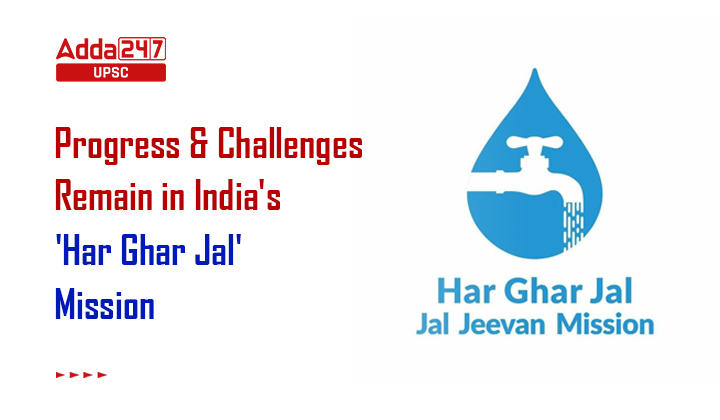Table of Contents
Har Ghar Jal Mission also known as Jal Jeevan Mission is an initiative taken by the Ministry of Jal Shakti, under the central government of India. Its primary objective is to ensure that every household in the country has access to piped water supply. By 2024, the mission aims to provide safe and sufficient drinking water through individual tap connections to all rural households in India.
Why Har Ghar Jal in News?
Har Ghar Jal Mission 2024: India must give a bigger push to scheme to deliver potable water. Access to potable tap water remains a pressing issue for millions of households in rural India, despite ongoing efforts to fulfill Prime Minister Narendra Modi’s promise of piped, potable water for all rural households by 2024. While significant progress has been made, challenges and concerns continue to hinder the ambitious ‘Har Ghar Jal’ mission.
Har Ghar Jal Mission – Access to Potable Water
- As of now, approximately 64% of rural households, or about 19.5 crores, have access to piped water connections.
- This marks a substantial increase from the 16% figure in 2019 when the mission was initiated.
- This falls short of the targeted goal, and it is unlikely that all of rural India will be connected by April 2023, as initially envisioned by Prime Minister Modi.
Har Ghar Jal Mission – Impediments and Delays
- Government officials attribute the slow progress to the impact of the COVID-19 pandemic.
- The ongoing Russia-Ukraine war has reportedly impeded access to necessary resources such as pipes and civil construction required for the mission.
- These unforeseen circumstances have caused delays and hindered the pace of implementation.
Har Ghar Jal Mission – Significant Strides
- Despite the challenges, the ‘Har Ghar Jal’ mission has made commendable strides, with approximately nine crore households now having exclusive access to piped water.
- Additionally, connections have been established in village schools, anganwadi’s (childcare centers), and community buildings.
- However, even with this progress, it is unlikely that 75% of households will be connected by the given timeline.
Har Ghar Jal Mission – Village Certification
- One of the concerns surrounding the reported figures is the reliance on data provided by the states.
- The Jal Shakti Ministry‘s numbers solely depend on the data reported by each state, leaving room for potential discrepancies.
- For instance, only 1,68,157 villages have been reported as ‘Har Ghar Jal’, with just 35% being certified by their respective gram panchayats.
- Most villages have only half or three-fourths of their households connected, indicating an incomplete achievement.
Har Ghar Jal Mission – Independent Assessment
- To obtain a clearer and more transparent picture of the mission’s progress, an independent assessment commissioned by the Jal Shakti Ministry sampled 300,000 households in 13,300 villages.
- The assessment reported that 62% of households were connected as of October last year.
- However, this sample size is limited and may not accurately represent the overall situation.
Har Ghar Jal Mission – Variations in State Performance
- Furthermore, it has come to light that states like Gujarat, Haryana, and Punjab, which already had a high base of connectivity in 2019, achieved 100% compliance more swiftly compared to others.
- This highlights the need for a comprehensive mechanism that provides regular and transparent updates on the scheme’s performance on the ground.
Women’s Role in Har Ghar Jal Mission
First ‘Har Ghar Jal Mission’ Certified State & UT
- In Goa and Dadra & Nagar Haveli and Daman & Diu (D&NH and D&D), people from all the villages have declared their village as ‘Har Ghar Jal’ through a resolution passed by Gram Sabha.
- Through these resolutions, Gram Sabhas certified that all households in the villages have access to safe drinking water through taps, ensuring that ‘No One is Left Out’.
- All 2.63 lakh rural households of Goa & 85,156 of Dadra & Nagar Haveli and Daman & Diu have access to potable water through tap connection.
- All schools, Anganwadi centers, and public institutions including Gram Panchayat buildings, healthcare centers, community centers, ashram shalas, and other government offices have now access to potable water through tap connection.
Way forward
As the ‘ हर घर जल योजना ‘ mission moves forward, it is imperative for the government to address the challenges and ensure the reliability of the reported numbers. Swift action is necessary to overcome the hurdles caused by the pandemic and other external factors. By implementing a transparent mechanism, the government can provide a clear assessment of the mission’s progress and work towards achieving its ambitious goal of providing piped, potable water to every rural household in India.
Analysis of Yojana Magazine: Jal Jivan Mission
Analysis Of Sansad TV Discussion: Jal Jeevan Mission
Why Har Ghar Jal is Relevant for UPSC Exam?
- GS Paper 2: Governance, Administration, and Challenges– Government policies and interventions for development in various sectors and issues arising out of their design and implementation.
| Follow US |
|
| UPSC Govt Jobs UPSC Current Affairs UPSC Judiciary PCS Download Adda 247 App here to get the latest updates |



 TSPSC Group 1 Question Paper 2024, Downl...
TSPSC Group 1 Question Paper 2024, Downl...
 TSPSC Group 1 Answer key 2024 Out, Downl...
TSPSC Group 1 Answer key 2024 Out, Downl...
 UPSC Prelims 2024 Question Paper, Downlo...
UPSC Prelims 2024 Question Paper, Downlo...




